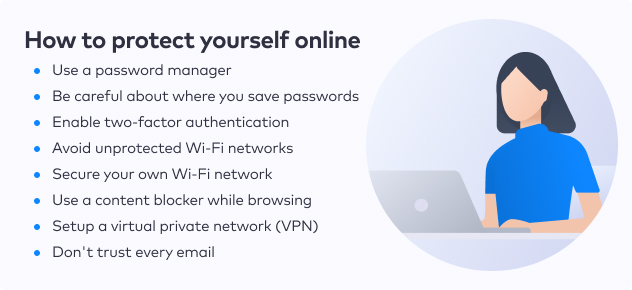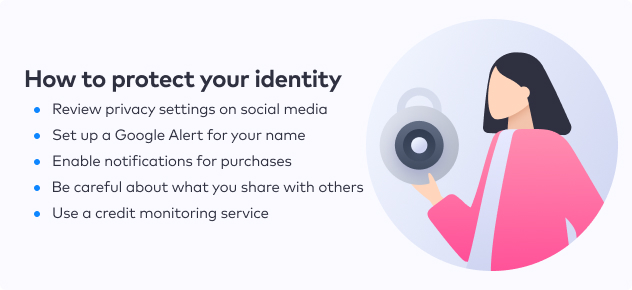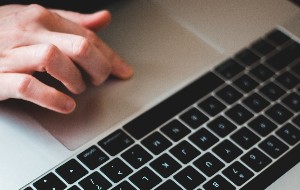In this article you will find the following:
What does it mean to stay private online?
Protecting your privacy online means limiting the amount of data you share as much as possible. You're always going to have to give up some to use the online services many of us have come to rely on nowadays, but there are ways that you can ensure that the data you do provide doesn't end up in the wrong hands. By limiting what you share, you'll make it more difficult for others to gain access to your online accounts, find out things you don't want everyone to know, and steal your identity for things like credit cards and loans.
Of course, there are different levels of online privacy, depending on what kind of data you want to hide and who you want to hide it from. While it's a good idea for everyone to follow practices that can help prevent things like identity theft and account loss, for instance, you may also have reasons to hide other things like the status updates and photos you share to social media. You'll find tips for all of these things in this guide.
How to protect yourself online

- Use a password manager
- Be careful about where you save passwords
- Enable two-factor authentication
- Avoid unprotected Wi-Fi networks
- Secure your own Wi-Fi network
- Use a content blocker while browsing
- Setup a virtual private network (VPN)
- Don't trust every email
Use a password manager
Using the same password for all of your online services is one of the most common mistakes many internet users make. It might be convenient, but if your login details for just one account are leaked, it means everything else is also compromised. Set yourself up with a secure password manager — such as 1Password, Dashlane, or LastPass — which will help you create and store secure passwords that are easily accessible anywhere.
A good password manager is protected by strong encryption, making it almost impossible for your data to be obtained by anyone else, and they're available across all your devices. This makes it easier to quickly access your favorite services without having to remember different account details — or writing them down on paper (another big no-no). Many password managers can also securely store credit card details, documents, and more.
Be careful about where you save passwords
While using a secure password manager is safe and convenient, you should be careful about saving your passwords elsewhere. You don't want those passwords to be made easily accessible to someone else if your smartphone or laptop gets stolen. If you must save your passwords to a browser, ensure it's one that requires a password — like Safari. And don't save passwords in notes and plain text files that can be opened by anyone.
Enable two-factor authentication
Using secure passwords that are different for every website you use is just one way of bolstering your online security. Another is to enable two-factor authentication for all services that support it. Two-factor authentication requires you to enter a temporary code as well as your password to gain access to services like Amazon, Gmail, PayPal, and lots more.
This code is either sent to you by text or email, or obtained through an app like Google Authenticator. When you have two-factor authentication enabled, it means that even if your password for one website is leaked, no one can access your account without also having access to your phone or email account.
Avoid unprotected Wi-Fi networks
We've all used unprotected Wi-Fi networks in hotels, coffee shops, and other public places when cellular connectivity isn't so good — or we've run out of data — and we need to access the internet. But did you know that public Wi-Fi networks are incredibly insecure? They're commonly used to intercept browsing traffic to gain access to a user's data.
The best thing you can do to stay safe in public is simply avoid connecting to unprotected Wi-Fi networks. Stick to using the cellular data network as much as possible, or wait until a protected Wi-Fi network is available to you.
Secure your own Wi-Fi network
For the same reasons mentioned above, you should ensure your own Wi-Fi network is secured by a password that ensures only you and the people you trust are able to connect to it. When you leave it unprotected, anyone nearby can connect to your network without your knowledge and use it to intercept your browsing traffic or for other nefarious activities.
Use a content blocker while browsing
Almost every website you visit tracks what you do online, so no matter how secure your password is, someone somewhere (usually advertisers) are finding out all kinds of things about you that you probably don't want them to know. It's easy to prevent that by using content blockers inside your web browser.
Some browsers, such as Safari, have certain protections built-in that make it more difficult to track you. But a dedicated content blocker like 1Blocker for Safari, uBlock Origin for Chrome, or Privacy Badger do a much better job of ensuring that your browsing habits remain completely anonymous. As an added bonus, many also block pesky online ads. MacKeeper’s StopAd feature, available for Safari and Chrome, is an option that will help you protect against unwanted intrusion in this manner.
Setup a virtual private network (VPN)
For even greater protection while using the internet, you might choose to use a secure virtual private network (VPN), such as Private Connect, MacKeeper's integrated VPN, or ExpressVPN, NordVPN, or Private Internet Access.
A VPN hides your browsing activity so that no one else — not even your internet service provider in some cases — can see what you're doing while you're on the web.
Don't trust every email
One of the most common ways cybercriminals obtain a user's login information is through phishing emails. These are spoof emails that are designed to look like they come from a genuine, trusted source that usually ask you to login to an online account. They include links to websites where any details you enter are sent straight to an attacker.
To ensure you don't become a victim of phishing emails, don't trust everything that lands in your inbox. Check the sender's email address to ensure it's a genuine email address, and look out for things like typos and images that don't look quite right — these are usually signs that the email is from a malicious source.
If you're not sure if an email can be trusted, simply visit websites manually. For instance, if you're asked to log into your bank to read a message, open your browser and enter the bank's web address yourself, rather than clicking the link in the email, so that you know you're visiting the real site.
How to protect your devices

- Use a password
- Install antivirus software
- Keep your software up to date
- Use encrypted backups
- Enable remote device wiping
Use a password
We now rely on digital devices to do almost everything, which means all our smartphones, tablets, and laptops are packed with sensitive information. Protect yours with a password and other security protections if they're available — like fingerprint scanners and facial recognition — to ensure that others cannot gain access to them if they're lost or stolen.
Install antivirus software
Some cybercriminals use malicious software like spyware to gain access to a victim's personal data. To prevent this, use a trusted antivirus program — like MacKeeper Antivirus with its real-time protection, Microsoft Defender, Bitdefender, or Norton — to prevent malicious software from taking over your computer. Antivirus programs not only help prevent these things from being installed in the first place, but they can also remove any viruses that have already infiltrated your machine.
Keep your software up to date
Even trusted software can ship with bugs and vulnerabilities that leave them open to attackers, so developers regularly roll out software updates to make them more secure. Ensure the software you use everyday — especially your operating system and browser — are up to date, and install new updates as soon as you can to get the latest protections.
Use encrypted backups
If you're backing up data to a computer or a cloud-based storage, ensure that it is protected by encryption — like Dropbox, Google Drive, or iCloud. Encryption prevents your data from being unlocked without your password, so even if someone gets hold of your backup files, they won't be able to open them.
Avoid backing up sensitive data to unprotected hard drives and memory cards. These things can be easily lost or stolen, and if they're not protected by a password and encryption, anyone can connect them to a computer and access everything you've saved.
Enable remote device wiping
Many modern devices not only let you track their location in case they got lost, but also allow you to remotely wipe their data in the event that they end up in the wrong hands. If your device supports this feature — Android, iOS, Windows, and macOS do — then it's a great idea to enable it. If any of your devices goes missing and you're sure it can't be recovered, you can login to your account online and clear your data from anywhere.
How to protect your identity

- Review privacy settings on social media
- Set up a Google Alert for your name
- Enable notifications for purchases
- Be careful about what you share with others
- Use a credit monitoring service
Review privacy settings on social media
Many of us enjoy documenting our lives on social media. But if you're not careful, the information you post online could help someone else steal your identity. Ensure that only those you trust can see this information by reviewing your privacy settings on social media platforms like Facebook, Instagram, and Twitter.
All of these services have a setting that prevents others from seeing what you post unless they are accepted as a friend or follower, so random people cannot visit your profile and see what you're up to. Once you've enabled this setting, remove any friends or followers you do not know personally, and only accept friend requests from those you trust.
In addition, avoid posting pictures or updates that contain personal information, such as your address, date or birth, and social security number.
Set up a Google Alert for your name
One thing many people are unaware of is that you can set up a Google Alert for your name, so that when it appears online, you're notified of it. This can be incredibly handy if you're worried about someone else posing as you online, or creating new accounts in your name. To set up a Google Alert, visit the Google Alerts page and enter your name.
Enable notifications for purchases
If you're worried about having credit card details stolen (and we all should be), then it's a good idea to set up emails, text alerts, or push notifications for purchases — if you haven't already. This will ensure you're notified every time your credit or debit card is used. If your bank doesn't support these things, be sure to keep a close eye on your balance and recent transactions so that you spot anything suspicious as soon as possible.
Be careful about what you share with others
You might be able to trust close friends and family members with your personal information, but you can't be sure that they take their online security as seriously as you do. Before you share sensitive information with others, ask yourself whether you would feel comfortable if one of their devices was lost or stolen, or one of their accounts was compromised, and that information was out in the open.
Avoid sharing things like credit card details and images that contain sensitive data with others as much as possible. And if ever you do share these things, ensure that the person you've shared them with keeps them safe, or deletes them when they're done.
Use a credit monitoring service
If a malicious actor gains access to enough of your personal information, they may use it to apply for things like credit cards and loans in your name. By using a credit monitoring service like CreditWise, Experian, or IdentityForce, you'll be notified every time your credit file is accessed by a lender. You will also be able to keep an eye on your credit score.








